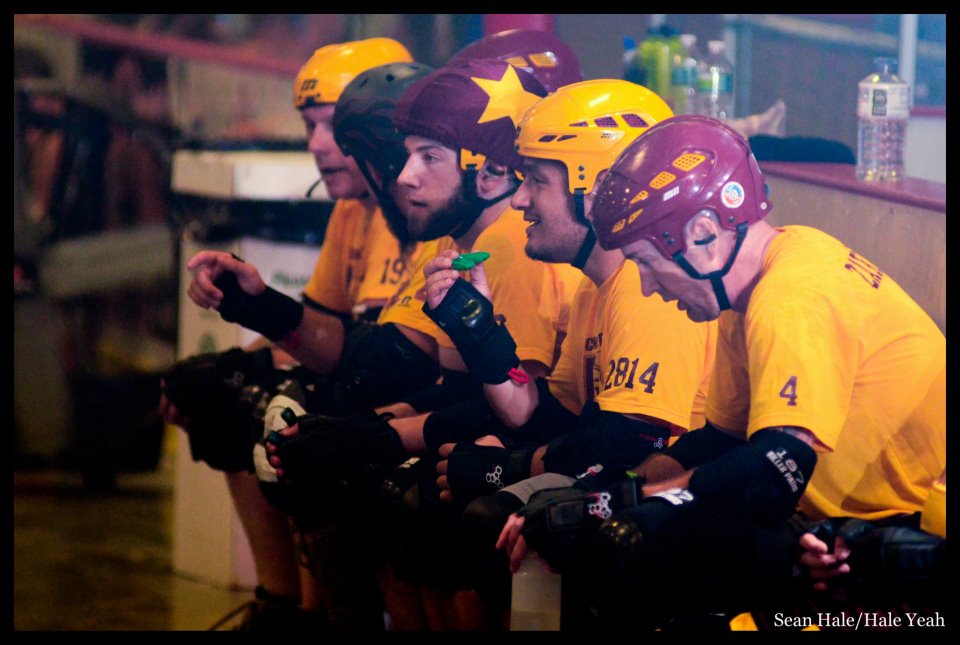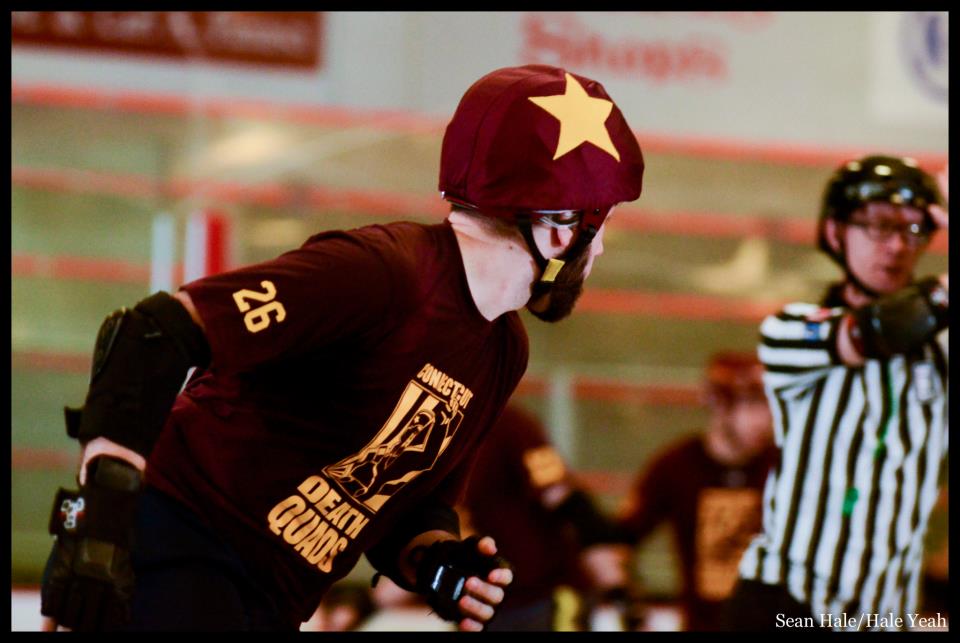
“Call me H.G. Welts,” he said, extending a hand. “That’s my skater name.”
I was in a strip mall parking lot to catch a ride to Sunday night practice with the Death Quads, the men’s roller derby team from the suburbs of Connecticut. I had learned of them from a flyer at a vegetarian restaurant in New Haven. “Join the roller derby revolution,” it said in golden characters. The team’s logo was a goateed man, attired like a soldier in the trenches and raising a single fist. The fine print: “Men 18+” and “Primary Insurance REQUIRED.”
Welts did not look like the athlete I’d expected, much less one to embody his sobriquet. He was 5’10”, 175 pounds, and entering middle age. His hair was still sprouting in curly black tufts, but wrinkles lurked at the corners of his eyes beneath his glasses. He seemed closer to vegetarian than brute, as did his girlfriend, Metal Malady, who was waiting patiently in the passenger seat of the gray SUV.
Welts joined the Death Quads last spring. Metal had been skating with the local girls’ team, CT Roller Girls, since July 2011, when the sport was still almost entirely female. Welts often tagged along—he wanted to learn to skate. Lacking a full roster, the men of the Death Quads constantly asked him to come to their practices. “As soon as I can let go of the wall,” Welts always responded.
“I’m just sitting around at a desk on the computer all day,” he told me. Welts is a civil engineer, designing and overseeing construction of water mains, storage tanks, sewer pump stations, “basically anything that takes water to your house or takes waste away, we’re doing it.”
He’d been working at the same company for nearly two decades, and wanted a physical outlet. Welts decided to see what roller derby was all about. To the uninitiated, a roller derby bout seems like a nonsensical blur, a mob jostling each other around the track. The bout is divided into rounds, called “jams,” that can last up to two minutes. Each team has five players skating at once, four blockers and a jammer, who scores points for every opposing blocker he passes.
Some escape the nine-to-five routine with tropical vacations; others get involved in charity. Welts takes to his skates. There is nothing surprising in this. Anyone could cherish what Welts loves about derby: the speed and smoothness of revolutions in the rink; the mystical vibration of another man’s shoulder crashing into your rib-cage; the familiar ache of exhaustion.
Like Welts, the majority of the Death Quads’ first skaters joined because of women.
Some coached or refereed women’s bouts, but more often, a boyfriend wanted to participate in the game that obsessed his girlfriend. Modern-day roller derby began as a feminist revival of a sport dating to 1935, when twenty-five co-ed teams competed in a month-long race that simulated the distance from Los Angeles to New York. By 1973, the sport had all but died, dropping its athleticism for scripted violence. Derby reemerged sporadically through the ’80s and ’90s, with added spectacles—one variation had alligator pits—but derby as it’s practiced today was resurrected in a bar in Austin, Texas, in 2001. In little over a decade, the sport has exploded into 1,100 female
teams.
Men’s roller derby—sometimes condescendingly referred to as “merby”—began in 2006 with the founding of the Dirty Dozen from Northampton, Massachusetts, who faced the New York Shock Exchange in their first match in 2007. Bonnie Thunders of New York’s Gotham Girls led the feminist charge against men’s intrusion into what she referred to as “our sport,” saying that men needed to create their own sport or play one of the dozens they already had. Since then, she’s “evolved” on the issue, largely because she needed co-ed support to bring roller derby to the mainstream. The Gotham Girls and Shock Exchange now scrimmage once a month, and the Men’s Roller Derby Association now has thirty-one member teams, including Southern Discomfort in London and Mont Royals in Quebec. But roller derby is still far from achieving equality between the sexes. The Death Quads, the fourth men’s team in the world, draws few fans compared to the team they practice with, the CT Roller Girls. The Roller Girls have two full travel teams and three more for home games, while the men can barely fill out a single team roster.
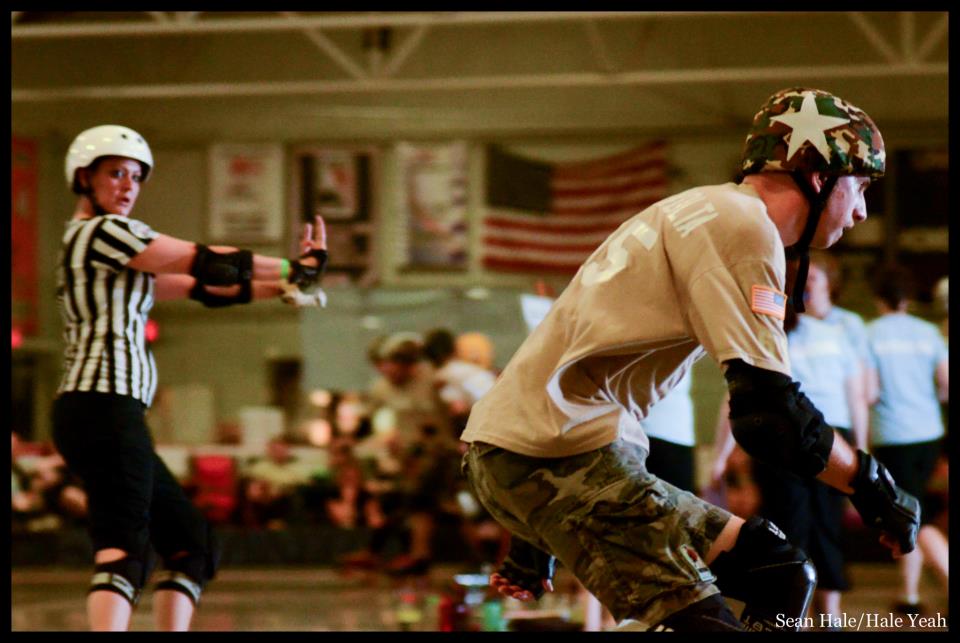
As the sky at dusk darkened to a bruised purple, we arrived at the RollerMagic Roller Rink in Waterbury for coed practice. The place was a time capsule of 1970s trendiness. Geometric murals wobbled on the walls, dimly lit by a web of pink, yellow, and white neon tubes on the ceiling. The worn blue carpet swirled with green eddies and snakes, looking like hard swampwater; arcade games floated precariously atop. Dante, one of the men, said the floor pattern has been the same since he was five. The pimply teenagers behind the full-service snack bar were finishing their shifts and clocking out—literally. One by one they punched their cards on an old-school machine, one that some of the skaters might have been familiar with from their own adolescence. In the middle of all this, the large skating rink looked timeless, its polished maple gleaming faintly.
The Death Quads are coached by a short but stunningly muscular woman named Pearl Jammer. She ordered the men and women onto the rink to run laps and Circle Jerk, a founder and co captain, led the pack. He looks like what you might expect from a guy who willingly dubbed himself Circle Jerk: he ran barefoot, pink-and-yellow hair almost as fluorescent as the neon lights above, hoop earrings dangling from his lobes. When he first gathered a group in 2008, it was the fourth men’s team in the world. C.J. wanted the team to be called the Circle Jerks, until the other captain, Skatebreed, objected. An assistant at a banking firm and now the team’s president, Skatebreed then adopted a name from a local group of punk musicians, the Death Squads, dropping a letter to match the sport’s four-wheeled quad skates. C.J. and Skatebreed fit the sport’s older demographic, guys too old for contact in lacrosse and ice hockey who still wanted a team sport, or maybe skateboarders who had never played on a team but now wanted a chance.
Pearl Jammer led the group through highkicks, lunges, squats, grapevines, and an exercise involving primordial crawling across the floor. By the time they’d finished with push-ups, the guys were sweating. The women popped up, ready for more. After another lap, the two teams put on their skates, protective helmets, elbow pads, knee-pads, wrist guards, and mouth guards.
Girl Fawkes, the men’s team manager, sat on a tabletop wearing Pokémon hot pants over stockings. She skates with the Stepford Sabotage (a group self-described as a meeting of Betty Crocker and Betty Ford), the top women’s travel team. She says the men have had difficulty recruiting new members.
Roller derby has changed rapidly over the last few years as the sport’s governing boards experimented with new rules to improve the emerging sport. Their efforts have been successful: roller derby now sometimes makes it into a newspaper’s sports section, rather than lifestyle. Some high-profile skaters talk of one day playing at the X Games, maybe even the Olympics. But roller derby’s founders are pulled between competing interests: they want the sport to gain an audience and respect, but they don’t want to lose their punk origins by going mainstream.
“I still love that I get to play this really off-beat sport,” Fawkes said. “Before roller derby I did not do anything athletic. I was a poetry-club, film-student, read-a-book-in-the-dark geek. I do not want to skate and get hit. But it was just entrancing.”
Folsom Bruise (real name Laurie Lawless, a roller derby name in its own right) had skated over to ask Fawkes about her wheels. Folsom said she was the same way: athletically challenged.
“I didn’t play anything in high school. I partied a lot. This is pretty much the first time in my life I’ve done anything competitive,” she said. After she got her life together in college, Folsom worried she would regress without the structure of school. But there was roller derby. “Roller derby saved my soul,” she said. “In a weird way.”
The guys practiced a few more drills for the next week’s match in Albany, working on their offensive blocking. Pearl Jammer called them over. “Be there by four,” she said. “We are in maroon.”
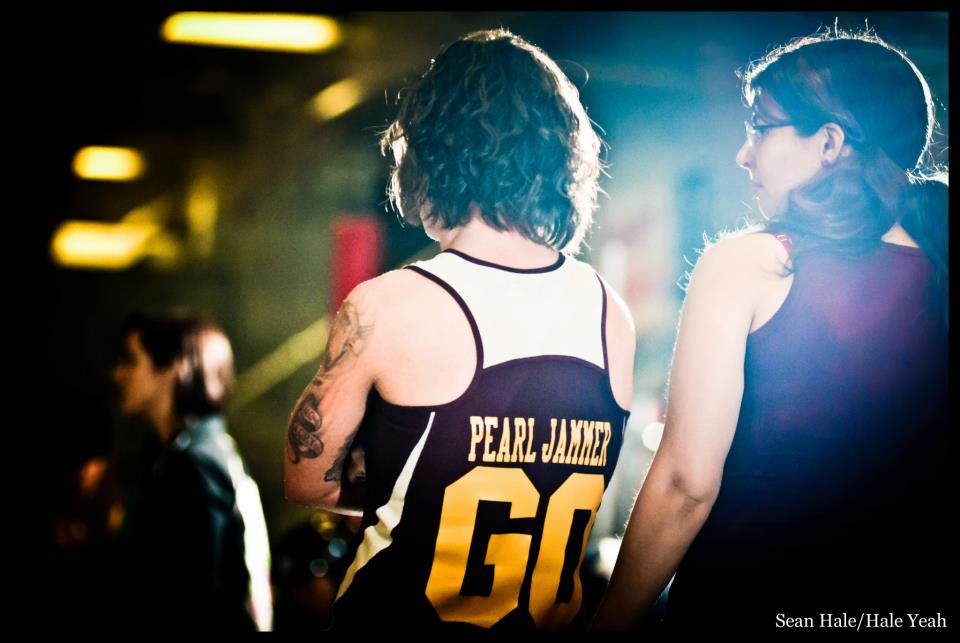
The Albany fans “are a bunch of douchebags,” Fawkes warned everyone. “But why worry about things you can’t control?”
“Can we swear at the fans?” a tall man asked.
“Read your fucking rulebook,” Fawkes said.
“You can swear,” another guy whispered to him. “Just not excessively.”
Welts and Malady walked back to the car, apologizing that I would have to sit next to them in their “stinky derby gear” on the way home. As we drove, Welts couldn’t stop talking derby.
“Sometimes, you’re there, standing up straight. The next thing you know your feet are out from under you, and you’re falling, going whichever way gravity takes you.” He chuckled at the thought, the way you do in daylight, as you remember details of a baffling dream.
I met Welts again the following Friday in Fair Haven at Channel 1, a tiny showroom and gallery within a former swimsuit factory. The Death Quads had organized a screening of This is How I Roll, a documentary on the struggles men’s derby has faced for recognition equal to their female peers. The guests milled about, chatting and sipping Narragansetts beneath a projection of a Death Quads game against the Magic City Misfits from Florida. Skatebreed hoped the event would raise funds for tournament travel and attract new recruits.
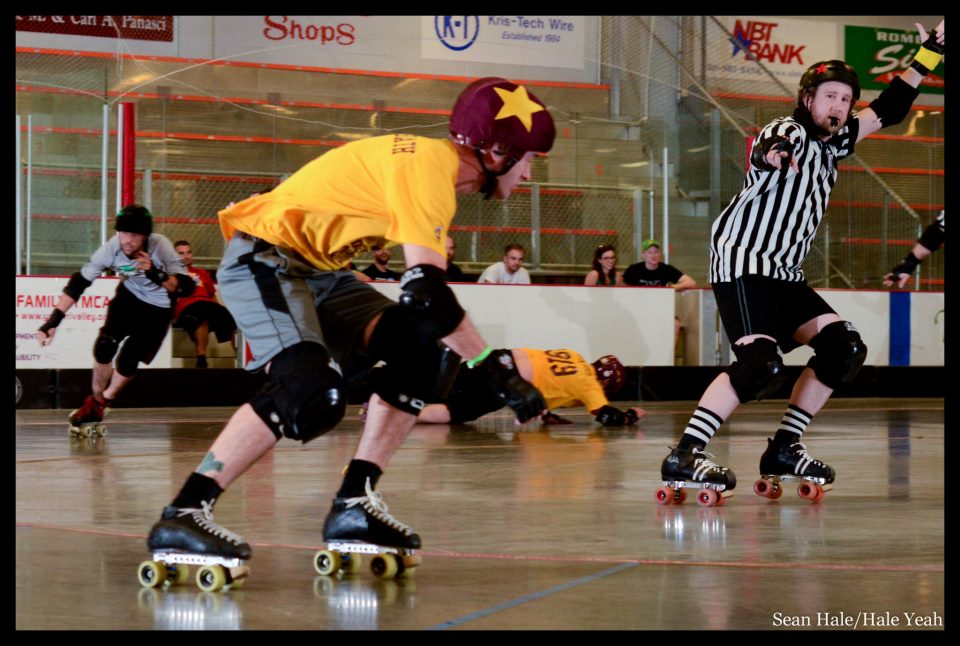
The Death Quads are currently the thirteenth-best men’s team in the world, their identity caught in limbo between all-star team and beer league. On one side is Crashasuarus Rex, who joined in 2010 after a lengthy search that took him through road cycling, mountain biking, jiu jitsu, and mixed martial arts. He describes himself as “competitive” and says he plays to win. A former college athlete, Rex is still young and attractive, the kind of guy who would look good smiling on the winner’s podium. But the team’s founders are an older group whose bodies often can’t keep up. One of the first recruits, Pastor of Muppets, has been benched while he recovers from stomach surgery.
Welts ended the replay of the game (which they eventually had lost) to cue the movie. “I don’t have floor lighting or anything like that,” the Channel 1 host said. “If you’re afraid of the dark…hold somebody’s hand.” The documentary focused on the men of the Shock Exchange, whose captain was scheduling matches before he had even drafted a team. After the movie I talked with Maulin’ Brando, one of the Shock Exchange’s first players. “God, we were awful,” he recalled. During their first games, is team could barely skate, let alone race. “Now we are all doing tricks and skating backwards. It’s amazing how far the sport has come in such a short period. I guess we knew we were bad. We were judged against this template that women had already established.”
While women’s roller derby has sped to underground fame and even broken through to mainstream culture with derby-themed episodes of The Bachelor, CSI, What Not to Wear, Top Chef, Psych, and Bones, men’s derby still lags behind. Most of the guys seemed happy enough watching the briefer and more obscure history they had lived, even though most of the scenes with the Death Quads had been cut.
But Skatebreed seemed disappointed. The team had made a bit of money selling snacks and admission, but it wasn’t the turnout he hoped for. I was one of the few people there who wasn’t a derby player already or a friend of the Death Quads. “We’ve kind of struggled,” Skatebreed said. “It’s really rough actually.”
The night’s event was largely uneventful. No recruits had signed up. It seemed to Skatebreed that the men’s roller derby revolution wasn’t happening unless it was played before a TV audience. Worrying about funds, recruits, exposure, he seemed to miss the point. The men of the Death Quads, businessmen and engineers, had already achieved a slice of roller derby glory. I’d seen it at the first practice, in the flashes of Death Quad skates, humming across the polished maple floor of the RollerMagic Roller Rink.


